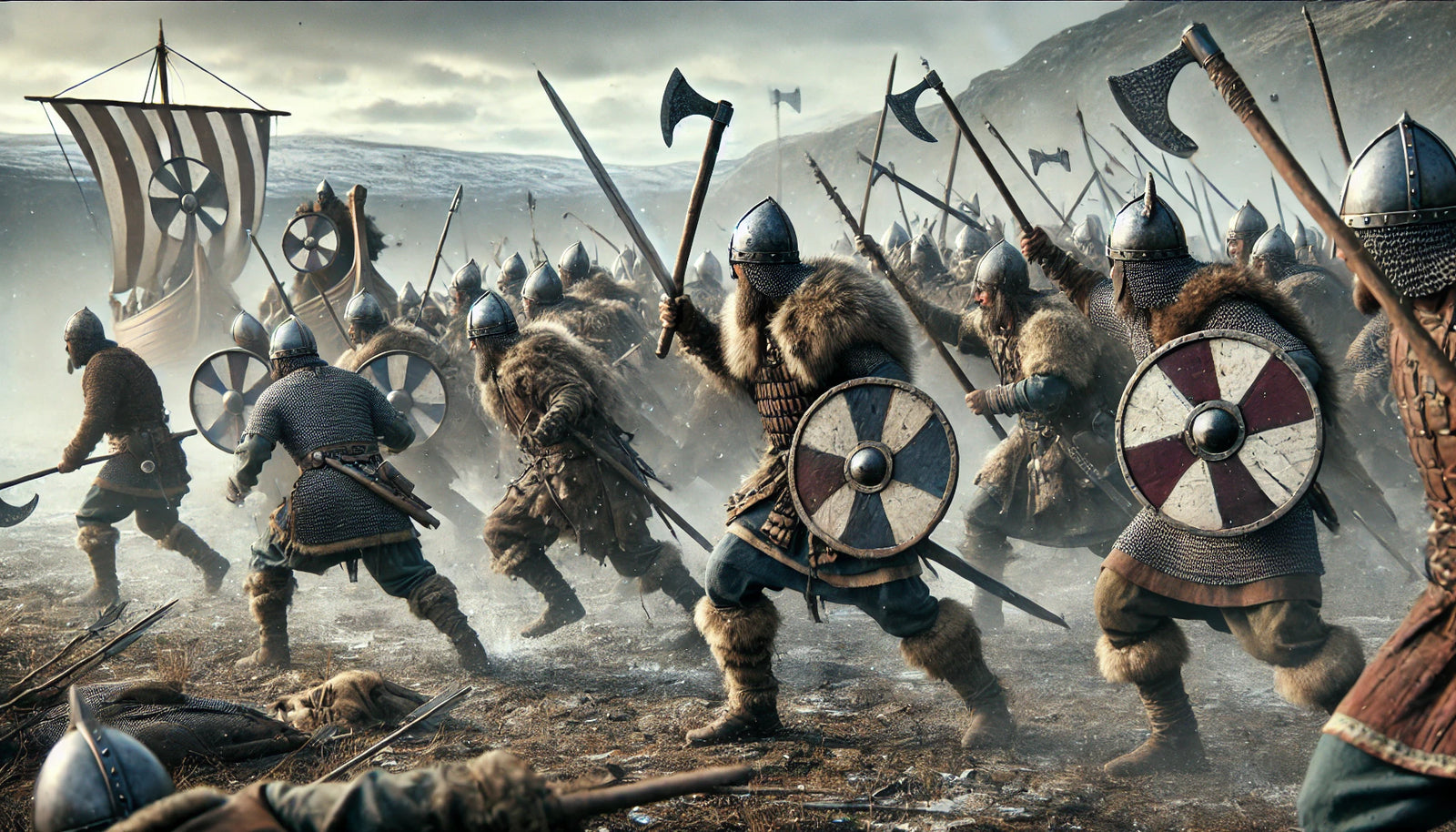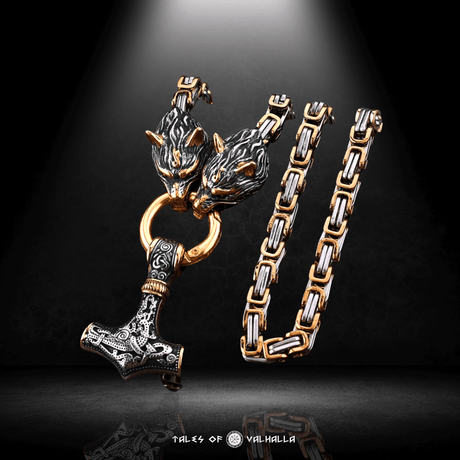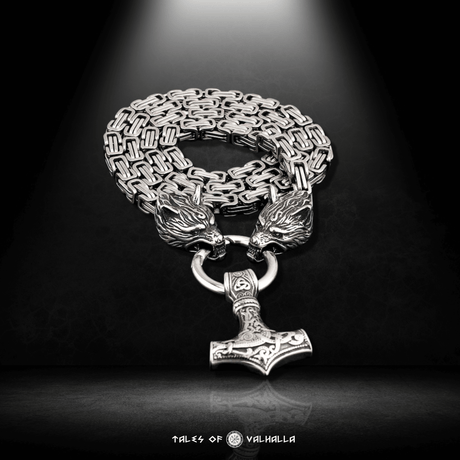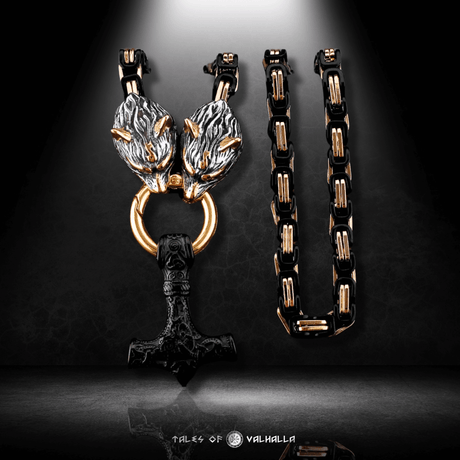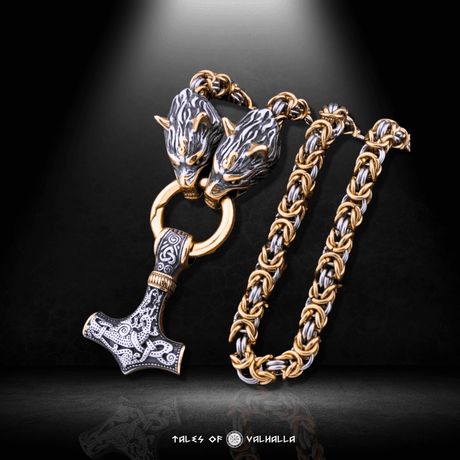The Viking Age, spanning from the late 8th to the early 11th century, is often remembered for its fearless warriors, epic sea voyages, and the brutal yet strategic warfare that enabled the Norsemen to conquer vast territories across Europe. The Vikings were more than just raiders; they were skilled tacticians and expert craftsmen, forging weapons that would become legendary. This blog takes you on an in-depth exploration of the weapons, tactics, and warrior culture that defined Viking warfare and solidified their place in history.
The Arsenal of Viking Warriors
The Viking warrior's arsenal was both diverse and deadly, reflecting their need for versatility in battle. From the noble sword to the fearsome axe, each weapon had its own significance and purpose on the battlefield.
Swords: The Symbol of Viking Nobility

Viking swords were not just tools of war; they were symbols of power, status, and craftsmanship. Often owned by the wealthiest and most elite warriors, these swords were meticulously crafted from high-quality steel. The double-edged blades, measuring around 70 to 90 centimeters in length, were designed for both slashing and thrusting, making them highly effective in close combat.
The hilt of a Viking sword was often richly decorated, featuring intricate designs and sometimes inlaid with precious metals or stones. These embellishments were not merely for show; they reflected the owner's wealth and social status. Many Viking swords were named, imbuing them with a sense of personality and prestige.
The process of making a Viking sword was complex, involving the forging of iron and steel into a single blade, often using pattern welding to create a distinctive, wavy pattern. This technique not only added to the sword's strength but also made each blade unique. As the Viking Age progressed, swords became lighter and more balanced, improving their effectiveness in battle.
Axes: The Versatile Weapon of Choice

Axes: The Versatile Weapon of Choice
While swords were prized possessions, axes were the most common weapon among Viking warriors. The axe was a versatile tool, used not only in combat but also for everyday tasks like chopping wood. This accessibility made it a popular choice for the average Viking.
Viking axes came in various shapes and sizes, from small hand axes that could be wielded with one hand to large two-handed battle axes designed to deliver powerful blows. The most iconic of these was the bearded axe, named for its extended lower blade, or "beard." This design allowed the axe to be used for both cutting and hooking, making it a formidable weapon in skilled hands.
The psychological impact of facing a Viking armed with a battle axe cannot be underestimated. The sight of a warrior swinging a massive, razor-sharp blade, capable of cleaving shields and armor, was enough to instill fear in even the most hardened opponents. Axes were also easier to produce than swords, making them widely available to Viking warriors.
Spears: The Staple of Viking Armament

Spears: The Staple of Viking Armament
Spears were among the most versatile and widely used weapons in the Viking arsenal. They were favored for their reach and adaptability, used both for throwing and thrusting. A typical Viking spear consisted of a wooden shaft, usually around two to three meters long, tipped with an iron spearhead.
There were several types of spears, each with its own tactical use. Some spears were designed for throwing, known as javelins, while others were intended for close combat. The spearhead's shape could vary, with some featuring barbed or winged designs to increase damage upon impact.
In battle, Viking warriors would often form a phalanx, with the front ranks holding their spears out to create a deadly barrier against charging enemies. Spears were also used in hunting and could be thrown with great accuracy and force. The ability to engage enemies from a distance made spears an essential part of Viking warfare.
Bows and Arrows: The Vikings' Long-Range Advantage

Bows and Arrows: The Vikings' Long-Range Advantage
Though less emphasized than melee weapons, archery played a crucial role in Viking warfare. Viking bows were typically made from yew, ash, or elm, with a draw weight of around 100 pounds, allowing for powerful shots over long distances. Arrows were crafted from wood and tipped with iron arrowheads, which were often barbed to cause maximum damage.
Viking archers provided crucial support in both raiding and open warfare. They could weaken enemy lines before the main assault, pick off key targets, or harass retreating foes. In naval battles, archers were particularly effective, as they could rain arrows down on enemy ships from the safety of their own decks.
The importance of archery in Viking warfare cannot be overstated. While the Viking reputation as fierce close-combat fighters is well deserved, their ability to engage enemies from a distance gave them a significant tactical advantage.
Viking Warfare Tactics
The effectiveness of Viking warfare lay not only in their weapons but also in their battle tactics. The Vikings were masters of strategy, employing a combination of psychological warfare, clever formations, and swift, decisive strikes.
Shield Walls: The Backbone of Viking Defense

Shield Walls: The Backbone of Viking Defense
One of the most famous Viking battle tactics was the shield wall, a formation in which warriors stood shoulder to shoulder, their shields overlapping to create a nearly impenetrable barrier. This tactic was particularly effective in defensive situations, allowing the Vikings to hold their ground against numerically superior foes.
The shield wall was not just about defense; it also allowed the Vikings to advance in unison, pushing back enemy lines with coordinated force. Warriors in the front ranks would use their spears or swords to strike at the enemy through gaps in the shields, while those behind them provided support and protection.
This tactic required discipline and coordination, as a single breach in the wall could be disastrous. The psychological impact of facing a well-organized shield wall was immense, as it appeared as an unyielding force, slowly advancing and crushing anything in its path.
Raiding: The Pillars of Viking Success

Raiding: The Pillars of Viking Success
Raiding was more than just a means to acquire wealth; it was a way of life for the Vikings. These swift, brutal attacks were conducted with precision and planning. The element of surprise was crucial, allowing the Vikings to overwhelm their targets before they could mount a proper defense.
Raids were typically launched from the sea, with Viking longships enabling warriors to travel vast distances quickly and strike deep into enemy territory. The mobility of the Vikings allowed them to target isolated monasteries, villages, and towns, looting treasure and taking captives to sell as slaves.
The success of these raids was not only due to the Vikings' superior weaponry and tactics but also to their ability to adapt. They were opportunistic warriors, quick to exploit weaknesses and retreat when necessary. This flexibility made them formidable opponents, capable of striking fear into the hearts of those along the coasts of Europe.
Naval Warfare: Mastery of the Seas

Naval Warfare: Mastery of the Seas
The Vikings were unparalleled seafarers, and their naval prowess was a key component of their success in warfare. Viking longships were marvels of engineering, designed for speed, agility, and durability. These ships could navigate both open seas and shallow rivers, giving the Vikings access to a wide range of targets.
Naval battles were not uncommon, and the Vikings developed tactics to maximize their advantages on the water. They would often use their ships to ram and board enemy vessels, engaging in close combat on the decks. Viking sailors were also archers, capable of launching volleys of arrows before closing in for the kill.
The flexibility of Viking ships allowed them to conduct amphibious assaults, landing warriors directly onto enemy shores. This capability made them a constant threat to coastal settlements, as they could strike without warning and disappear just as quickly.
The Viking Warrior Culture
The effectiveness of Viking warfare was rooted in their warrior culture, which emphasized courage, loyalty, and a deep connection to their gods. The Viking warrior was not just a fighter but a participant in a larger, spiritual struggle.
The Code of Honor: Courage, Loyalty, and Glory
Viking warriors lived by a strict code of honor, where courage in battle, loyalty to one's comrades, and the pursuit of glory were paramount. To die in battle was considered the highest honor, as it ensured a place in Valhalla, the hall of the slain, where warriors would fight and feast until the end of the world.
This belief in an afterlife filled with eternal battle made the Vikings fearless in combat. They fought with a ferocity that often stunned their enemies, driven by the desire to achieve a glorious death. Loyalty to their chieftain and comrades was also crucial, as Viking warriors relied on each other to survive the chaos of battle.
The pursuit of glory was not just a personal endeavor but a collective one. A warrior's reputation was of utmost importance, and tales of bravery and skill were recounted in sagas, ensuring that their deeds would be remembered long after their death.
Berserkers: The Fiercest Warriors of the North

Berserkers: The Fiercest Warriors of the North
Among the Viking warriors, none were more feared than the berserkers. These legendary fighters were said to enter a trance-like state in battle, becoming immune to pain and capable of extraordinary feats of strength. The term "berserk" comes from the Old Norse words "berr" (bare) and "serkr" (shirt), suggesting that these warriors fought without armor, relying on their rage and ferocity to protect them.
Berserkers were often associated with the worship of Odin, the chief of the Norse gods, who was himself a god of war and wisdom. Rituals and ceremonies were performed to invoke the berserk state, which was believed to be a gift from Odin. In this state, berserkers were said to be uncontrollable, attacking friend and foe alike until their rage subsided.
The existence of berserkers is supported by both historical accounts and archaeological evidence, though some aspects of their legend may have been exaggerated over time. Nevertheless, the image of a berserker charging into battle, howling with fury, has become an enduring symbol of Viking ferocity.
Valkyries and the Afterlife: The Warriors' Eternal Reward

Valkyries and the Afterlife: The Warriors' Eternal Reward
For the Vikings, death in battle was not the end but the beginning of an eternal journey. The Valkyries, warrior maidens serving Odin, were believed to choose the bravest of the fallen and carry them to Valhalla. There, the warriors would join the Einherjar, Odin's chosen army, to prepare for Ragnarok, the final battle that would end the world.
This belief in an afterlife filled with endless battle and honor provided Viking warriors with a powerful motivation. The fear of death was mitigated by the promise of eternal glory, and this belief influenced their approach to warfare. To die in battle was the ultimate goal, and to be chosen by a Valkyrie was the highest honor.
The mythology of the Valkyries also served as a form of psychological warfare. The knowledge that their enemies might not fear death, but welcome it, would have been unsettling to those who faced the Vikings. This belief system, intertwined with their warrior culture, made the Vikings some of the most relentless and determined fighters in history.
Conclusion
The Viking Age left an indelible mark on history, not only through the territories they conquered but also through their contributions to military tactics and weaponry. The Vikings were not just raiders and pillagers; they were masterful warriors with a deep understanding of the art of war.

